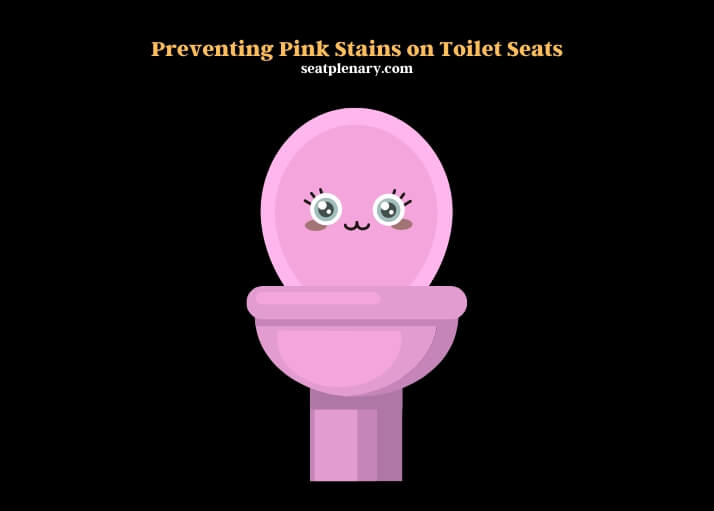The pink stain on your toilet seat is likely caused by the growth of Serratia marcescens, a type of bacteria. This bacterium thrives in moist, warm environments and can produce a pink or reddish film on surfaces when it multiplies.
The appearance of pink stains in bathrooms, especially on toilet seats, is a common concern that can be attributed to several factors beyond just bacterial growth. These stains are not only a sign of bacterial presence but also indicate the conditions within the bathroom that allow such organisms to flourish. High humidity levels and consistent moisture are ideal for the proliferation of Serratia marcescens.
The situation is exacerbated in bathrooms that lack proper ventilation, as stagnant air contributes to moisture retention on surfaces. Regular cleaning and maintenance of the bathroom are crucial in preventing the development of these pink stains. It involves not just the use of effective cleaning agents that are designed to kill bacteria but also ensuring that the bathroom is well-ventilated and dry.
Paying attention to the types of products used in the bathroom, from cleaning agents to personal care items, can help in minimizing the risk of staining.
The underlying causes and taking proactive measures can significantly reduce the occurrence of pink stains, ensuring a cleaner and healthier bathroom environment.

Behind the Pink Toilet Seats
The unexpected appearance of pink stains on toilet seats often puzzles homeowners. These stains are primarily caused by Serratia marcescens, a bacterium thriving in moist environments. This microorganism produces a pink pigment when it multiplies, signaling its presence on wet surfaces. Factors such as high humidity levels, lack of ventilation, and infrequent cleaning routines create ideal conditions for these bacteria to flourish.
The use of certain cleaning agents can inadvertently feed these microorganisms instead of eliminating them, exacerbating the problem.
Environmental conditions play a significant role in bacterial growth. Homes with consistent moisture, such as bathrooms without proper ventilation, are hotspots for Serratia marcescens. Regular cleaning can help, but the choice of cleaning agents is crucial. Some products may leave residues that feed the bacteria, while others might not be effective against them.
Water Quality’s Role in Toilet Seat Stains
Water quality significantly influences the formation of pink stains on toilet seats. Hard water, rich in minerals like calcium and magnesium, can deposit these minerals on surfaces, providing a breeding ground for bacteria. An analysis of water composition reveals that areas with hard water report more frequent occurrences of pink stains.
| Water Hardness Level | Frequency of Pink Stains |
| Soft Water | Rare |
| Moderately Hard Water | Occasional |
| Hard Water | Frequent |
This table illustrates the correlation between water hardness and the likelihood of encountering pink stains. Hard water facilitates the deposition of minerals, which, combined with the presence of Serratia marcescens, leads to the pink discoloration observed on toilet seats.
Solutions for Pink Stain Removal
Finding effective cleaning solutions for pink stains involves evaluating both chemical and natural options. Chemical cleaners, while potent, may pose risks to household safety and contribute to environmental pollution. Natural alternatives, such as vinegar and baking soda, offer a safer, albeit sometimes less effective, solution.
| Cleaning Method | Effectiveness | Safety |
| Chemical Cleaners | High | Low |
| Natural Cleaners | Moderate | High |
This comparison highlights the need for a balanced approach, considering both the effectiveness of the cleaning method and its safety implications. Regular use of appropriate cleaning agents, combined with physical cleaning tools, can effectively manage and prevent pink stains.
Preventing Pink Stains on Toilet Seats
Preventive measures are key to maintaining stain-free toilet seats. Regular cleaning schedules, proper ventilation, and controlling humidity levels in the bathroom can significantly reduce the risk of bacterial growth.
Use of antimicrobial toilet seats offers an extra layer of protection by inhibiting bacterial colonization on the surface.

Health Concerns Linked to Pink Bathroom Stains
While Serratia marcescens is not typically harmful to healthy individuals, it can pose risks to those with compromised immune systems. Maintaining high standards of bathroom hygiene is essential to prevent the spread of this bacterium. Regular cleaning, proper ventilation, and the use of appropriate cleaning agents can help mitigate health risks associated with pink stains.
FAQs
Can Toothpaste Cause Pink Stains?
It might surprise some to learn that toothpaste, especially those with certain dyes and ingredients, can contribute to the development of pink stains on toilet seats. When toothpaste residue is not thoroughly rinsed off and finds its way onto the toilet seat, it can create an environment conducive to bacterial growth, particularly if the bathroom is not well-ventilated or if the seat is seldom cleaned.
This scenario underscores the importance of maintaining cleanliness not just on the toilet seat but in the entire bathroom to prevent such occurrences.
Does the Type of Toilet Cleaner Matter?
The type of toilet cleaner used can significantly influence the appearance of pink stains. Some cleaning products contain substances that may not effectively kill bacteria like Serratia marcescens but instead provide them with nutrients to thrive.
Opting for cleaners specifically designed to combat bacterial growth without encouraging it is crucial. Researching and selecting products known for their antibacterial properties can make a substantial difference in preventing the recurrence of pink stains.
Is the Color Change in My Toilet Seat Related to Mold or Bacteria Growth?
If you’re dealing with a blue toilet seat, the color change could be related to mold or bacteria growth. Mold can appear as a blue-green discoloration, while certain bacterial growth can also cause a blue tint. It’s important to thoroughly clean and disinfect the toilet seat to prevent further growth.
Can Shower Products Contribute to Pink Stains?
Shower gels, shampoos, and other bathing products often contain dyes and ingredients that, when left on surfaces such as toilet seats, can lead to pink stains. These products, combined with the humid environment of a bathroom, create a perfect breeding ground for bacteria. Ensuring that shower products are kept away from the toilet area and that any spills are cleaned up promptly can help mitigate this issue.
Is the Age of the Toilet Seat a Factor?
The age of a toilet seat might influence its susceptibility to pink stains. Over time, scratches and wear on the surface of the toilet seat can harbor bacteria more easily than a newer, smoother surface. These micro-abrasions provide tiny niches for bacteria to lodge and multiply, making older seats more prone to staining. Regular inspection and replacement of toilet seats can be a preventative measure against such staining.
Can Diet Influence the Color of Toilet Stains?
While it might seem far-fetched, the diet of individuals using the toilet can indirectly affect the color of stains. Certain foods and medications can alter the pH balance of urine, which, when combined with existing bacteria on the toilet seat, might result in a change in the color of the stains. This factor is more about the interaction between bodily fluids and bacteria rather than the diet causing the stains directly.
Are Some Water Treatments Responsible?
Water treatments, particularly those involving chlorine and other chemicals, can affect the microbial balance in household water. In some cases, these treatments might not eliminate all bacteria, allowing those like Serratia marcescens to survive and eventually find their way onto surfaces like toilet seats. Investigating and understanding the water treatment methods used in one’s locality can provide insights into potential factors contributing to the presence of pink stains.
In summary, pink stains on toilet seats are a sign of bacterial presence, influenced by environmental factors and water quality. Effective cleaning and preventive measures can control and eliminate these unsightly blemishes, ensuring a clean and healthy bathroom environment.
